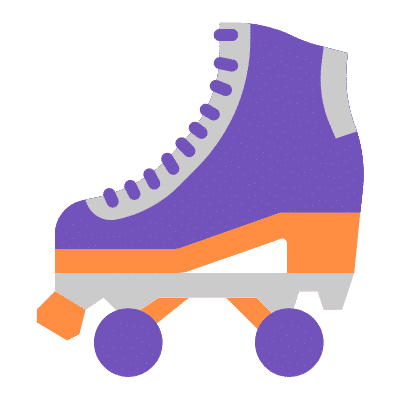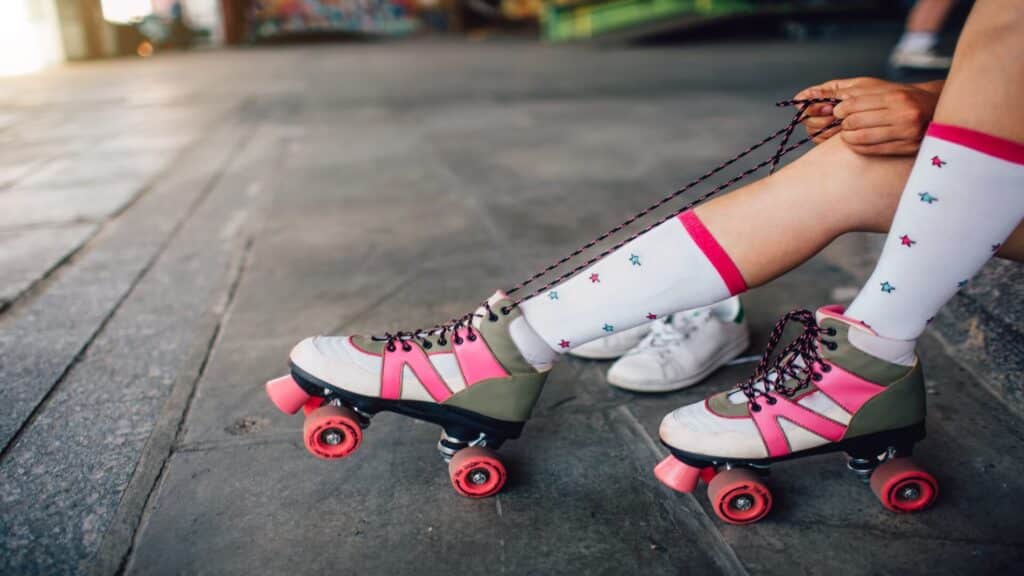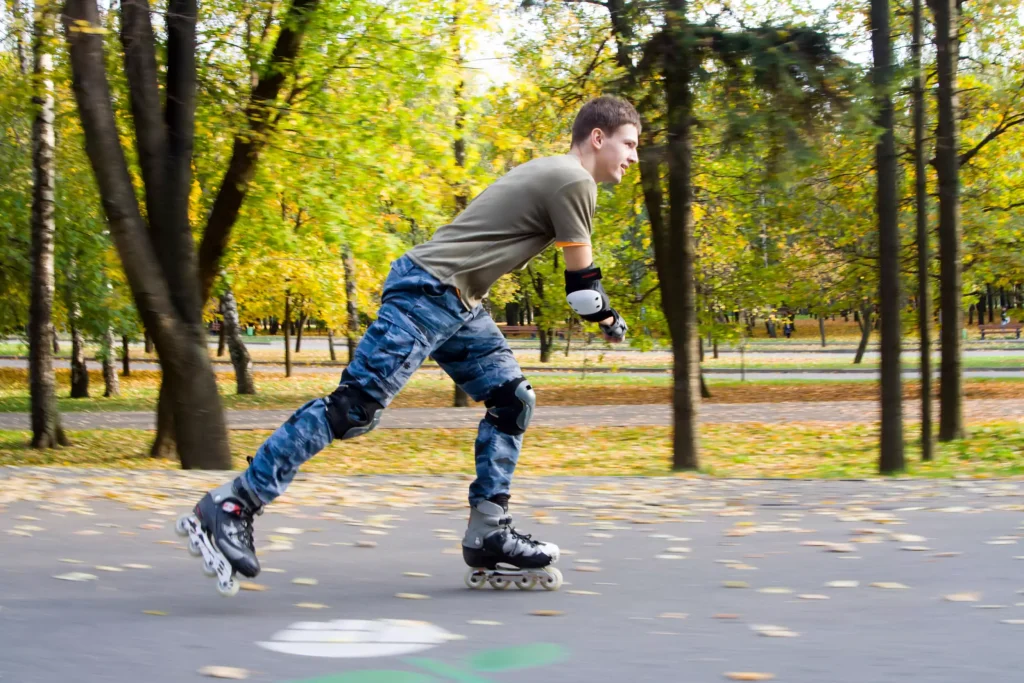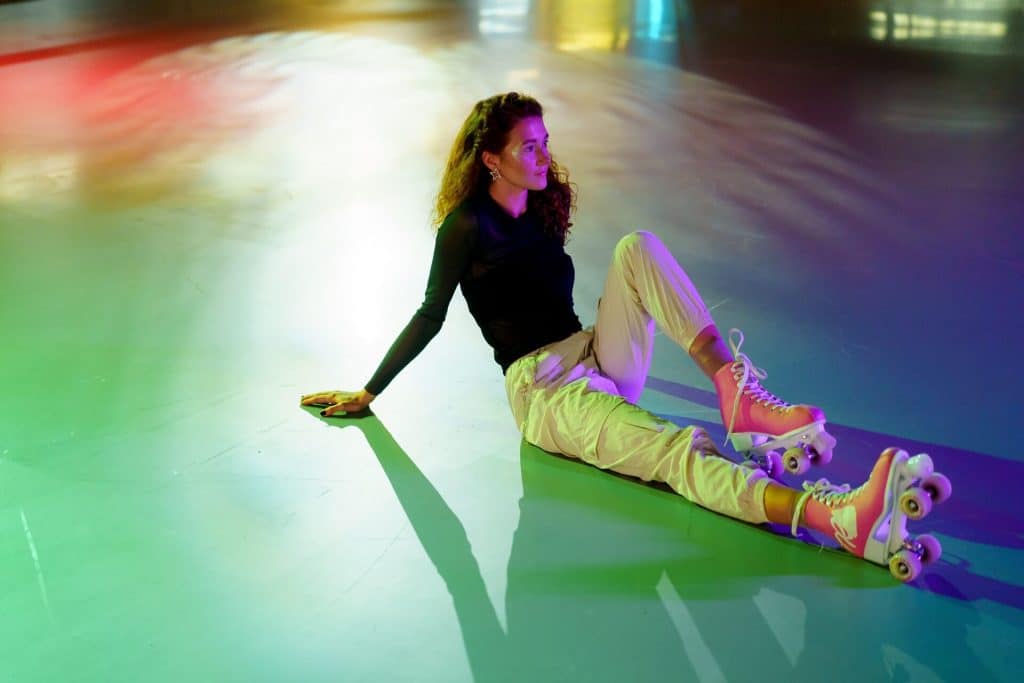Learning how to spin in roller skate is not only a milestone for anyone but also a fantastic way to mix up your routine with some enjoyable and beneficial exercise. Once you have learned the basics and feel comfortable skating, you should improve your skating skills even more.
You can start by learning simple moves like spinning, skating backward, and gliding on one foot. We’ll give you some advice today so you can master the art of spinning on skates. You’ll soon be wowing your buddies at the skating rink by spinning like a professional.
Table of Contents
Building Confidence Off Skates
Mastering skating spins happens faster if you condition the right muscles and coordination first off skates. Try these skill-building exercises in your regular shoes before hitting the rink:
- Balance Board/Bosu Squats – Stand on a balance board, Bosu, or even a folded towel. Perform squats focusing on keeping an upright stance without wobbling. Builds proprioception.
- Lunges with Rotation – Lunge forward, rotate torso open to side. Return to start and repeat, turning toward the opposite side each rep. Mimics spin motion.
- Seated Twists – Sit with knees bent, and feet on the floor. Keeping torso long, twist to one side using core muscles rather than momentum. Increase reps for endurance.
- Quick Skater Hops – Lightly hop side to side, mimicking roller skating stride. Focus on sticking each landing solidly with bent knees to improve stability.
Trying these off-skate drills will strengthen essential muscles and coordination so spins feel easier when you strap those skates on! Conditioning off the rink pays dividends for quick progress.
How to spin on roller skates for beginners
Skating in a spin may look complicated, but it’s actually relatively simple. Anyone who lacks the natural grace of a figure skater or the natural agility of a roller skater can learn how to spin on roller skates with a little effort and persistence.
Consider wearing protective gear like a helmet, kneepads, wrist guards, and an elbow protector before you get started. Skating confidently and easily is possible when you know you won’t hurt yourself if you take a tumble. Learning a new skating move almost always involves taking a tumble. What’s more, even if you fail the first time, you can get right back up and keep going!
Skaters should be aware that they must skate at a reasonable speed and in a comfortable position. Not having your knees locked would be in the most comfortable position. The most significant error is turning while moving too quickly. Let us find out how to turn around on roller skates.
Give yourself some room to breathe
Roller skating spins are a lot of fun to learn and require very little space in which to hone. Keep an eye on your surroundings and avoid running into other skaters, specifically if the rink is crowded. Avoid doing so when learning to spin on roller skates in a crowded area.
Set yourself up
Your posture is very important when you want to learn a roller skating trick. For a spin, you need to be balanced on your skates, with slightly bent knees, feet shoulder-width apart, and square hips.
Start the spin
As you begin skating, extend your arms out to the sides in the shape of a “T.” Lift your arms beside your body and rotate them to the same side. Your arms’ motion gives you the rotational momentum you need to enter the spin.
Keep it going
Move the skate on that side backward while sliding the other forward as your arms pull you into the spin. The left skate must move back, and the right skate should travel forward if you pull your arms to the left. Move your skates closer together and lengthen your body upward as your velocity increases.
A tutorial video that will teach you how to turn on roller skates.
Credit to INDY JAMMA JONES for this video.
Here you can read more of our guides to improve your skills:
- Basic Roller Skating Tricks
- How To Perform Backward Skating On Roller Skates
- How To Roller Skate Without Falling
- How To Feel More Stable On Your Roller Skates
Alternative Methods on how to spin on roller skates
Learning how to spin on roller skates isn’t as hard as it looks. It is one of the easiest tricks you can try when skating. It is one of the first things you should learn if you’re new to riding.
There are different methods to learn how to spin in roller skates, and each requires different skills and moves. If you want to skate more advanced moves in the future, it’s a good idea to perfect both of these. Nevertheless, even if you’re dipping your toes in this pool of new skills, you can choose the most comfortable method. Here are two alternative methods on how to turn on roller skates for beginners.
Method 1
This primary two-foot spin is driven almost entirely by arm and shoulder action. Turning in this direction requires a lot more work, but it could be the better choice for beginners. You should stand with your feet around shoulder-width apart if you want to conduct a two-foot spin.
The direction in which you intend to spin significantly impacts your body movements. Your feet will soon begin to move in opposite directions. As you initiate a left turn, put your right foot in front of you.
To begin, use your arms to spin your upper body in the direction you want to spin. Move your body forward while skating, pushing the front skate forward and the back skate backward. Your torso should be facing the way you turn as you bring the skates back together. As you spin, bring your arms in close to your body.
Method 2
The second method of spinning when skating needs a little more finesse but allows you to spin for longer if you want. Start by touching your toes to each other in a circle while wearing your skates before attempting the spin. Continue doing this movement until it feels natural to you.
Once you master this movement, you may spin more effectively and fluidly by skating between positions rather than stepping. Skate backward with one foot and forward with the other while keeping your heels out. Your left skate will skate backward, whereas your right skate skates forward if you rotate to the left. The polar reverse is true if you are rotating to the right.

Progressing to Advanced Spins
Once you’ve mastered the basic two-foot spin, you may be ready to try more challenging spin methods. Here is a progression guideline with difficulty ratings:
Beginner Spin (Rating: 1 out of 5)
The two-foot spin focuses on fundamental body rotation and momentum.
To perform:
- Stand with feet shoulder-width apart, knees slightly bent. Extend arms straight out to sides.
- Keeping core engaged, twist upper body and sweep both arms to one side. Turn your head and look in the direction of spin.
- As momentum builds, roll the right foot onto the toes while sliding the left foot back onto the heel.
- Complete full rotation, returning back to the start position with feet together and arms extended out.
Tips:
- Maintain an upright posture, avoid bending forward at the waist
- Rotate the core fully before moving the feet
- Start slow, and increase speed gradually once body rotation is smooth
Intermediate Spin (Rating: 3 out of 5)
The one-foot spin requires shifting all weight into one foot while using the other leg for balance.
To perform:
- Begin a two-foot spin, building momentum with an upper-body twist.
- Transfer weight to one foot, lifting the other leg out sideways. Extend both arms overhead if needed for stability.
- Keeping weight firmly through the standing leg, use small hops or pushes of the free foot to drive the spin rotation.
- Return to the start position with feet together before stopping spin.
Tips:
- Engage standing leg glutes and core to center weight
- Spot your gaze to a fixed point to avoid dizziness
- Start attempts slow, then increase power and speed
Advanced Spin (Rating: 5 out of 5)
Heel/Toe Spin – This spin is performed by rolling back and forth between the heel and toe of one foot while keeping the spin moving. It requires excellent balance and coordination.
To Perform:
- Gain momentum using core twist and arms extended out to the side.
- Shift weight into one foot, lifting the other leg up with the knee bent and arms overhead.
- Lean slightly forward and roll onto the toe stop of the standing foot while lifting the heel.
- Next, roll back onto the heel, lifting the toes up, keeping motion fluid.
- Repeat heel/toe roll over and over, using forward momentum to drive the spin.
- Return to the start position.
Tips:
- Keep knees bent & core tight throughout the spin.
- Spot your gaze to a fixed point to minimize dizziness.
- Try slower with a wider stance first before speeding up the rotation.
Tips for Progressing:
- Master slower spins fully before attempting faster rotations
- As you improve, bring arms closer to the body during spin for a streamlined form
- A tight core engages abdominal muscles for balance; don’t bend at the waist
- Keep knees bent & weight centered between feet as this maintains stability
Take the progressions step-by-step at your own pace. Smoother, swifter spins take time and practice! Stay motivated knowing more advanced skating skills await you!
Avoiding Common Mistakes
Learning to spin on skates takes practice, and it’s normal to make some mistakes as a beginner. Being aware of the common errors will help you identify and fix any issues quickly. Here are some typical mistakes to watch out for:
- Spinning too fast too soon – It’s tempting to want to spin quickly right away. But attempting fast spins as a beginner leads to slips, falls, and feeling dizzy. Go slow, perfect your form, and gradually build up speed.
- Locked knees – Spinning requires bending your knees to maintain balance and control. Locked, stiff knees often lead to wobbly spins that are hard to control. Keep soft knees bent throughout the spin.
- Poor weight distribution – Ideal weight distribution for spins is 70% on the back foot and 30% front foot. Leaning too far forward or back makes spinning and balancing tricky. Practice transfers between the front and back foot to get the right body position.
- Arms flailing – Using your arms correctly to initiate spin rotation is key. But don’t leave them flailing about once the spin starts. Bring arms in toward the body, with elbows bent at 90 degrees to stay controlled.
- Rushing the return after spin – After a series of spins, beginners often hurry to stand upright. Avoid getting dizzy or disoriented by slowly bringing your body back to the start position.
Mastering spins takes time and patience. Now that you know what errors to watch for, you can practice consciously and improve quickly! Take it step-by-step and don’t forget to have fun while learning this cool new skill.
The Importance of Protective Gear
Wearing appropriate safety gear should be the first thing you do before attempting any new roller skating tricks. Protective gear significantly reduces the risk of injury, allowing you to practice spinning with confidence. Here are some must-have items to keep you safe:
- Helmet – A helmet is essential head protection. Choose one that fits snugly with adjustable straps and vents to stay cool. The Triple 8 Sweatsaver Helmet is a popular choice offering comfort and adjustability.
- Knee Pads & Elbow Pads & Wrist Guards – For convenient all-in-one protection, the JBM Knee Pads & Elbow Pads & Wrist Guards provide a full coverage set. The adjustable and breathable pads offer durable construction suitable for mastering new skating techniques. The JBM protective set combines knee, elbow, and wrist guards in one handy package for beginners. By wearing these supportive pads, you can skate with confidence when practicing spins and other new tricks. The slip-on design and adjustable straps provide a customized fit.
Take time to find the right protective gear for your needs and budget. The safety equipment should fit properly but let you move freely. Now you can try those skating spins without fear! And if you do fall, you’ve got good padding to keep you smiling through the learning process.
Final Words
Learning how to do a spin on roller skates is an exciting skill that opens up a fun new world of skating tricks. With the techniques outlined in this guide, you now have the key tips to master skating spins safely as a beginner.
The step-by-step instructions take you from basic two-foot spins all the way to advanced heel/toe maneuvers. Along the way, be sure to reinforce the fundamentals – bend your knees, engage your core, start slow, and progress gradually to faster RPMs.
Be patient with yourself as you practice and don’t forget your protective gear. Take time to properly warm up muscles before attempting spins. Follow the common mistake pointers so you can self-correct effectively. Video record your spins to compare against the proper technique.
Learning how to execute a spin on skates does require a commitment to regular practice. But that practice pays off with the thrill of whirling across the rink smoothly. Skating spins are as much about building overall balance and coordination as just a cool trick. Add spins to your repertoire and prepare for lots of cheers and impressed smiles at the skate park!
With this complete guide to spins behind you, now is the time to get out on those skates! Wishing you safe, smiles, and skating success ahead!








